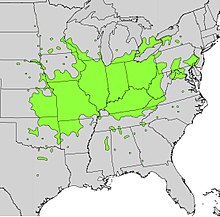Euonymus atropurpureus
| Euonymus atropurpureus | |
|---|---|

| |
| Scientific classification | |
| Kingdom: | Plantae |
| Clade: | Tracheophytes |
| Clade: | Angiosperms |
| Clade: | Eudicots |
| Clade: | Rosids |
| Order: | Celastrales |
| Family: | Celastraceae |
| Genus: | Euonymus |
| Species: | E. atropurpureus
|
| Binomial name | |
| Euonymus atropurpureus | |

| |
| Generalized natural range of Euonymus atropurpureus | |
Euonymus atropurpureus is a species of shrub in the bittersweet family. It has the common names American wahoo, eastern wahoo, burningbush[2] and hearts bursting with love.[3] It is native to eastern North America.
Distribution and habitat
This species is primarily found in the Midwestern United States, but its range extends from southern Ontario south to northern Florida and Texas.[4][5][6] It grows in low meadows, open slopes, open woodland, stream banks and prairies, in moist soils, especially thickets, valleys, and forest edges.[6]
Description
This section includes a improve this section by introducing more precise citations. (December 2023) ) |
It is a
cymes. The fruit is a smooth reddish to pink four-lobed (sometimes one or more of the lobes abort) capsule, up to 17 mm diameter, each lobe containing a single seed, orange with a fleshy red aril
.
Uses
The fruit is poisonous to humans, but is eaten by several species of
References
Wikimedia Commons has media related to Euonymus atropurpureus.
- . Retrieved November 20, 2021.
- ^ Weakley, Alan S. "Flora of the Southern and Mid-Atlantic States".
- ^ Nelson, Lewis S.; Shih, Richard D.; Balick, Michael J. (2009). Handbook of poisonous and injurious plants. New York Botanical Garden. p. 159.
- ^ Little Jr., Elbert L. (1977). "Euonymus atropurpureus" (PDF). Digital Representations of Tree Species Range Maps from "Atlas of United States Trees" by Elbert L. Little, Jr. (and other publications). United States Geological Service. Archived from the original (PDF) on October 18, 2011.
- ^ "Euonymus atropurpureus". Germplasm Resources Information Network. Agricultural Research Service, United States Department of Agriculture. Retrieved January 16, 2018.
- ^ a b Ma, Jinshuang; Moore, Gerry. "Euonymus atropurpureus" (PDF). United States Forest Service. Archived (PDF) from the original on June 16, 2015. Retrieved November 26, 2007.
- ^ "Euonymus atropurpureus". Plants for a Future.
- ISBN 0-394-50760-6.

